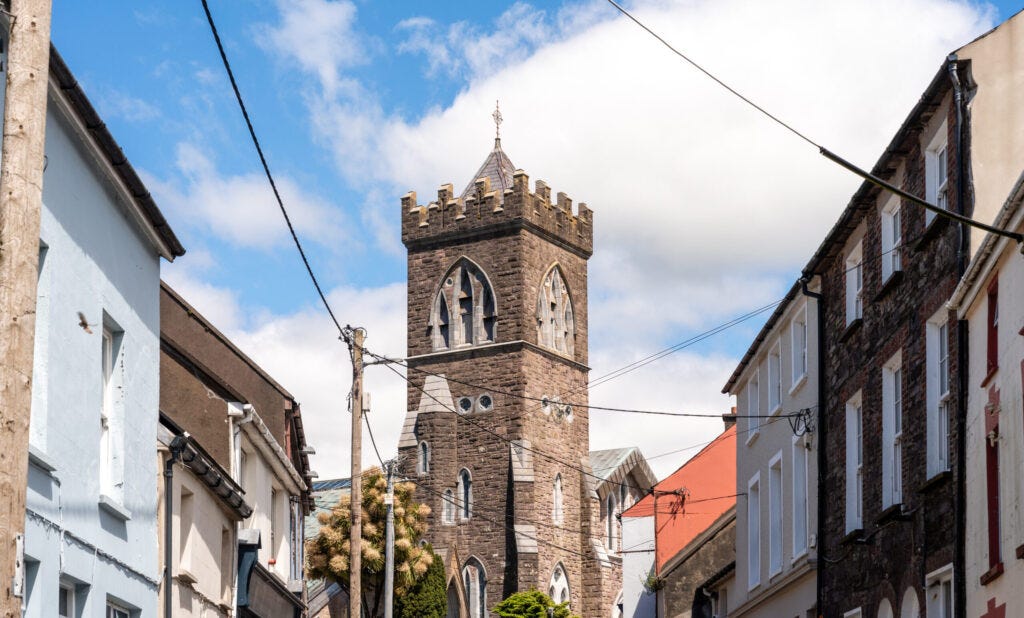In Need of New Benefactors
One Irish woman’s example of the monument and legacy we each can create.
*This article was originally published by Philanthropy Daily.
Rising above the colorful, vibrant store fronts and pubs in Dingle, Ireland, is the mid-19th century neo-gothic St. Mary’s Catholic Church. Constructed from layered Irish rock, the church exudes sturdiness and grit, testifying to the town’s past even as tourism reshapes its present.
On a recent vacation to my ancestral homeland on the Dingle Peninsula, I stepped inside the church to connect with my Irish roots. There were the typical trappings for Mass: pews, candles, the tabernacle, stained glass windows, and the Stations of the Cross.
What caught my attention were two plaques flanking the altar. One honored a priest from Dingle—the Rev. Daniel John O’Connell—who “during a long missionary career” was “distinguished for his zeal for the glory of God and the salvation of souls.” The other celebrated the church’s “most bountiful benefactress,” Clarissa Hussey.
According to the inscription, Hussey supported “religious and charitable institutions of this her native town,” and “for the same purpose she bequeathed all her property.” The church stands “chiefly at her expense,” after she donated reportedly £3,000, which equates to nearly half a million pounds today.
Hussey died on Aug. 14, 1864, at over 80 years old. (Coincidentally, I was in St. Mary’s Church on Aug. 13.) However, the plaque concludes: “As it is her resting place, so let it be her monument. People of Dingle, pray for her soul.”
Primary sources on her life are lacking—at least those readily available online. Her nephew, Samuel Murray Hussey—who was considered one of the “best known of Irish land agents”—described his aunt as “pious,” and she also often hosted priests for dinner.
I have no idea who Ms. Hussey was in life beyond these limited sources. Likely a wealthy landowner, Hussey clearly believed her resources were meant to serve God and her community. Whether from deep faith or compassion—or both—her generosity shaped a legacy that still stands.
For 160 years, her gift has provided a place of worship and peace for generations of parishioners and visitors, like me. Her donation was not a one-time act, but an investment in a community space where the Holy Spirit continues to work.
But her plaque also evoked a larger question: how many similar spaces, nonprofits or institutions—spiritual and secular—do we rely on without ever pausing to remember the benefactors who made them possible?
Too often, we take them for granted—but these institutions have allowed for a myriad of people to congregate, socialize, and engage with civil society, as well as contribute to a community’s needs. Their disappearance, on the other hand, elicits distress, sadness, and a hollowness in our neighborhoods, causing us to wonder how they could have faded away. (Even the loss of my local diner has left a pancake-sized hole in Milford, Conn.)
Human nature, however, is more prone to take than to give. That is why Jesus Christ’s call to “lay up for yourselves treasures in heaven” is still challenging two thousand years later because, indeed, “where your treasure is, there will your heart be also.” Donating and volunteering are sacrificial acts of love but grate against modernity’s shallow habit of imbibing in self-gratification, doom-scrolling, and avoiding all adversity or even disruption of our routines.
But civic life requires sacrifice. As Alexis de Tocqueville observed nearly two centuries ago, Americans constantly united to build schools, hospitals, churches, and countless associations. Civil society was never automatic—it was built by those willing to give. Indeed, institutions are not born from nothing, but built by people. From the mountains to the prairies to even across the ocean in Dingle, someone had to act. To give. To not hoard their treasure for themselves.
Hussey’s generosity shows how one person’s legacy can ripple across centuries, reverberating in the community and touching countless lives, even those we least expect.
One does not need to donate as much as Hussey, in terms of monetary value, but one can be a “bountiful” benefactor in their own right. Her monument is St. Mary’s Church in Dingle, as the plaque states. Our own can be a community program, nonprofit, festival, shelter, or even lifting up another soul from despair, pain, or strife.
Let us give thanks for those patrons who have come before, whose gifts still enrich our lives—and may we consider how we can do the same for our neighbors today and generations yet to come. Civil society depends on it.

